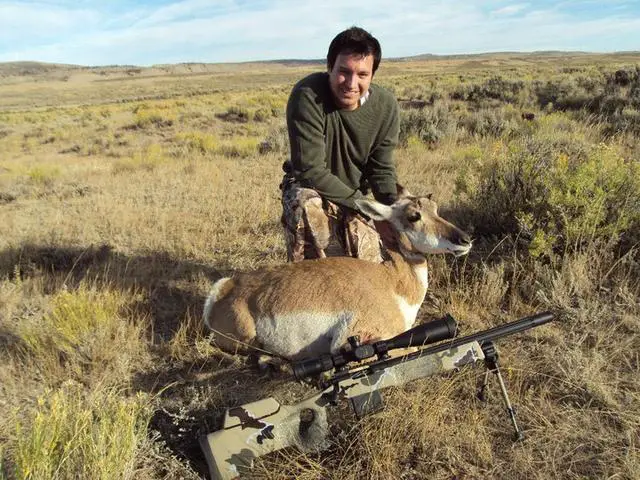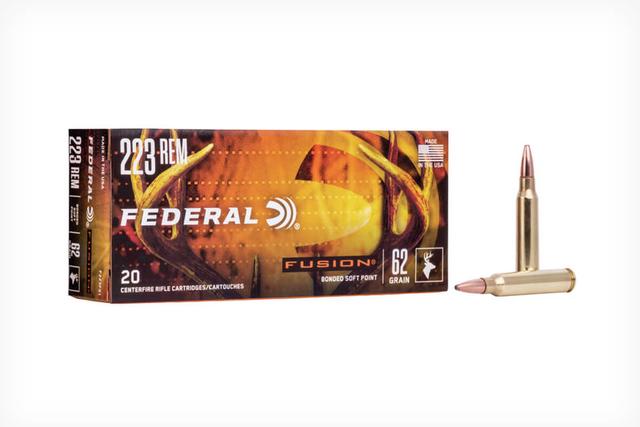“Unveiling the True Impact: Does It Cause Damage and Waste Meat? Dive into the consequential debate surrounding a controversial practice that may potentially harm and squander valuable meat resources. Gain insight into the potential repercussions and evaluate the need for change. Stay informed on this pressing concern.”
The Ethical Debate: Can the.223 Remington Cause Excessive Damage and Waste Meat?

The ethical debate surrounding the use of the.223 Remington for deer hunting revolves around whether or not it can cause excessive damage and waste meat. This is an important consideration because one of the cornerstones of hunting ethics is to take game as quickly and painlessly as possible.
To determine if the.223 Remington is suitable for deer hunting, we need to examine its capabilities in terms of bullet velocity, expansion, and penetration. The goal is for the bullet to reach the animal at a velocity that allows it to reliably expand and penetrate through bone, tissue, and organs to effectively disrupt oxygen production in the heart and/or lungs.
The effectiveness of the.223 Remington largely depends on the choice of bullets. Modern premium bullets, such as the ASYM 70-grain TSX Barrier/Hunting load, have greatly improved performance compared to older bullet designs. These bullets are designed to stay together and penetrate deeply. Many hunters have successfully used these bullets on whitetail deer without recovering a single bullet.
Other reliable bullet options include Swift Sciroccos, Nosler Partitions, and Hornady’s GMX. These bullets are known for their ability to penetrate and stay together adequately for most whitetails.
However, it’s important to note that there may be limitations when using the.223 Remington. It may not be suitable for taking shots at longer distances or from difficult angles. In situations where quick, tough shots are required, a more powerful cartridge may be necessary.
Ultimately, whether or not the.223 Remington is a good choice for deer hunting depends on shot placement and understanding its limitations. If used responsibly within its capabilities, it can be an effective cartridge for harvesting deer. However, if a hunter is not comfortable using it within those limitations or if they are targeting larger bucks weighing over 200 pounds, they may want to consider using a more powerful cartridge.
In conclusion, while there are pros and cons to using the.223 Remington for deer hunting, it can be a viable option when the appropriate bullets are used and shots are taken within its limitations. It’s important for hunters to be responsible and make ethical decisions based on their own comfort and understanding of the cartridge’s capabilities.
Balancing Knockdown Power and Meat Preservation: Examining the Effectiveness of the.223 Remington for Deer Hunting

The.223 Remington is a controversial cartridge for deer hunting due to its relatively small size and lower energy compared to larger calibers. However, with the use of modern premium bullets, the.223 Remington can still be an effective choice for ethical deer hunting.
The main concern when using the.223 Remington for deer hunting is whether it can reliably penetrate through both lungs of a whitetail at the intended range and shooting angles. This depends on factors such as bullet velocity, expansion, and penetration capabilities.
One recommended load for the.223 Remington is the ASYM 70-grain TSX Barrier/Hunting load. This bullet has been proven to stay together and penetrate deeply, making it suitable for deer hunting. Other bullets such as Swift Sciroccos, Nosler Partitions, and Hornady’s GMX are also reliable choices.
The advantages of using the.223 Remington for deer hunting include its forgiving recoil and ease of accuracy. The low recoil allows hunters to shoot accurately and build confidence in their rifle. Additionally, practice ammunition for the.223 Remington is less expensive compared to traditional deer cartridges, allowing hunters to practice more frequently.
However, there are limitations to using the.223 Remington for deer hunting. It may not be suitable for long-range or challenging shots where a more powerful cartridge would be necessary. In situations where quick, tough shots from bad angles are required, a more powerful cartridge is recommended.
In conclusion, while the.223 Remington may not be the ideal choice for all deer hunting scenarios, it can still be an effective cartridge when used within its limitations. Proper shot placement is crucial when using this cartridge, and hunters should be prepared to pass on shots that are beyond its capabilities.
Is the.223 Remington a Suitable Cartridge for Deer Hunting? Weighing the Pros and Cons

The article discusses the suitability of the.223 Remington cartridge for deer hunting. It states that there is no simple answer to whether or not this cartridge is suitable, as there are pros and cons to consider. The main concern when hunting deer is to ensure a quick and painless kill, which requires a bullet that can reliably expand and penetrate through bone, tissue, and organs.
The author shares their preferred load for the.223 Remington, which is the ASYM 70-grain TSX Barrier/Hunting load. They have had success using this load on whitetail deer and feral hogs, as it stays together and penetrates deeply. Other bullets mentioned that are known for reliable penetration include Swift Sciroccos, Nosler Partitions, and Hornady’s GMX.
One of the pros of using the.223 Remington for deer hunting is its forgiving recoil, making it easy to shoot accurately. Practice ammunition for this cartridge is also less expensive compared to traditional deer cartridges, allowing hunters to build confidence in their rifle. However, the article acknowledges that there are limitations to the.223 Remington. It may not be suitable for long shots or tough angles where a more powerful cartridge would be needed.
In conclusion, while the.223 Remington can be a viable option for deer hunting when used within its limitations and with appropriate bullets, it may not be the best choice for all situations. Hunters should consider factors such as shot placement and distance before deciding to use this cartridge.
The Realities of Using the.223 Remington for Deer Hunting: Does It Result in Excessive Meat Loss?

The.223 Remington is a controversial choice for deer hunting due to concerns about its knockdown power and potential for excessive meat loss. While there are pros and cons to using this cartridge, it ultimately depends on shot placement and bullet selection.
One of the main factors to consider when using the.223 Remington for deer hunting is whether the bullet can reliably penetrate through both lungs of the animal. This requires a bullet that can expand reliably and penetrate deeply enough through bone, tissue, and organs to disrupt oxygen production. Modern premium bullets, such as the ASYM 70-grain TSX Barrier/Hunting load, have been developed to meet these requirements.
The ASYM 70-grain TSX load has been tested successfully on whitetail deer without any recovered bullets. Other reliable bullets for penetration include Swift Sciroccos, Nosler Partitions, and Hornady’s GMX. These bullets can be relied upon to penetrate and stay together adequately for most whitetails.
One advantage of using the.223 Remington for deer hunting is its forgiving recoil, making it easy to shoot accurately. Additionally, practice ammunition for the.223 is less expensive compared to traditional deer cartridges, allowing hunters to build confidence in their rifle through regular practice.
However, there are limitations to using the.223 Remington for deer hunting. It may not be suitable for taking long shots or shooting from challenging angles where a more powerful cartridge would be necessary. In situations where quick, tough shots from bad angles are required, a more powerful cartridge is recommended.
In conclusion, while the.223 Remington can be an adequate deer cartridge when used with appropriate bullets and shot placement within its limitations, it may not be the best choice for all hunting scenarios. Hunters should consider their specific circumstances and choose a cartridge that will ensure ethical kills with minimal meat loss.
Assessing Shot Placement and Bullet Performance: Evaluating the Impact of the.223 Remington on Deer Meat Quality

Assessing Shot Placement and Bullet Performance: Evaluating the Impact of the.223 Remington on Deer Meat Quality
When considering the use of the.223 Remington for deer hunting, one important factor to consider is shot placement. The goal is to take down the deer as quickly and painlessly as possible. This requires a bullet that can reliably expand and penetrate deeply enough through bone, tissue, and organs to interrupt oxygen production in the heart and/or lungs.
The.223 Remington has been criticized in the past for lacking sufficient knockdown power for ethical deer hunting. However, advancements in modern premium bullets have made it possible for this cartridge to perform adequately. For example, the ASYM 70-grain TSX Barrier/Hunting load has proven to be effective in penetrating deeply and staying together upon impact.
The key to using the.223 Remington effectively for deer hunting is selecting appropriate bullets that can reliably penetrate through both lungs of a whitetail at the intended range and shooting angles. Bullets such as Swift Sciroccos, Nosler Partitions, and Hornady’s GMX are known for their ability to penetrate and stay together adequately.
While the.223 Remington may not be suitable for taking down larger bucks weighing over 200 pounds or for expensive trophy hunts, it can still get the job done when used within its limitations. It is important to choose shots carefully and pass on animals when the angle or distance isn’t right.
In conclusion, while there are pros and cons to using the.223 Remington for deer hunting, it can be an adequate cartridge when used with appropriate bullets and shot placement. It offers advantages such as low recoil, ease of accuracy, and affordability of practice ammunition. However, hunters must also be aware of its limitations and choose shots wisely.
Making an Informed Decision: Considering Both Sides of the Argument on Using the.223 Remington for Deer Hunting

The.223 Remington is a popular cartridge for deer hunting, but there is debate about its effectiveness. It is important to consider both the pros and cons before making a decision.
Pros:
– The.223 Remington can be an adequate deer cartridge when using appropriate bullets. Modern premium bullets, such as the ASYM 70-grain TSX Barrier/Hunting load, have improved performance and can reliably penetrate through both lungs of a whitetail.
– The.223 Remington is forgiving in terms of recoil, making it easy to shoot accurately. This is especially beneficial for hunters who may be new to rifles or are sensitive to recoil.
– Practice ammunition for the.223 Remington is less expensive compared to traditional deer cartridges. This allows hunters to build confidence in their rifle by practicing more frequently.
Cons:
– The.223 Remington may not be reliable for longer shots or when taking shots from bad angles. In situations where quick, tough shots are necessary, a more powerful cartridge may be needed.
– The.223 Remington has limitations and requires responsible shot placement. If the angle or distance isn’t right, it is important to pass on taking a shot.
– The.223 Remington may not be suitable for larger bucks weighing over 200 pounds or on expensive trophy hunts. In these cases, a more powerful cartridge would be recommended.
In conclusion, the.223 Remington can be a viable option for deer hunting when used within its limitations and with appropriate bullets. It is important to consider factors such as shot placement, distance, and size of the animal before deciding on using this cartridge.
In conclusion, while meat consumption is a significant contributor to environmental damage and food waste, it is important to strike a balance between enjoying meat responsibly and reducing its negative impact. By adopting sustainable practices, such as supporting local farmers, reducing portion sizes, and embracing plant-based alternatives, we can mitigate the detrimental effects of meat production while still enjoying this valuable source of nutrition.









